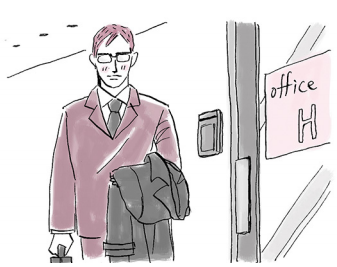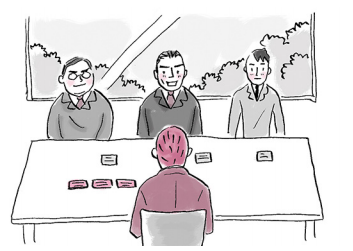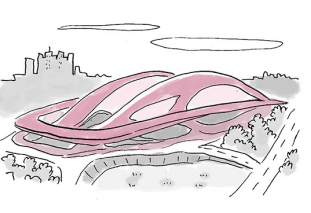Visiting a Company 会社を訪ねるとき
after - at - for - from - in - into - off - to - until - when - with
You should take (1 ) your coat or scarf before entering an office.
オフィスに入る前にコートは脱ぎ、マフラーはとりましょう。
When dealing (2 ) reception or an intercom, you should first state your company name and your own name, and (3 ) the following way you should announce an appointment or purpose:
受付やインターホンでの応対には、まず社名と名前を言い、約束があることや目的を次のように伝えます。
“I’m Smith (4 ) ABC company. Itsumo osewa ni natte orimasu.
「A BC社から参りましたスミスと申します。いつもお世話になっております。
I have an appointment with Mr. Suzuki (5 ) the sales department at 10:00.”
営業部の鈴木様と10時にお約束しております」。
When you are shown (6 ) a room, basically you should not sit unless invited to take a seat.
部屋に案内されたら、基本的に席を勧められるまで座りません。
If there is no invitation, avoid sitting (7 ) the best seats and wait in an inferior seat.
案内がない場合は、上座を避けて、下座に座って待ちます。
The best seats are (8 ) the far end of the room, while the inferior seats are closer (9 ) the entrance.
部屋の奥が上座、入り口近くが下座です。
When the person you are meeting comes (10 ) the room, immediately stand up and exchange greetings and business cards.
担当者が部屋に入ってきたら、すぐに立あがり、あいさつや名刺交換をします。
Wait to sit (11 ) the host takes their seat. In addition, if a boss or colleagues are present, only sit down (12 ) your superiors are seated.
訪問先の皆さんが座るまで待ちます。また、上司と同行した場合は、上司が座ってから、座ります。
If tea is served, it is better not to imbibe any (13 ) you are encouraged to do so.
お茶を出された場合、勧められてから口をつける方が良いでしょう。
After saying “Arigatou gozaimasu. Choudai shimasu” or “Itadakimasu,” hold the teacup (14 ) both hands and drink.
「ありがとうございます。ちょうだいします」や「いただきます」と、お礼を言ってから、両手で茶碗を持って飲みます。
Generally the visitor is the one who decides (15 ) it is time to leave.
帰るタイミングを切り出すのは訪問者からが一般的です。
You bow, saying, “Honjitsu wa ojikan wo itadakimashite, arigatou gozaimashita.” (Thank you (16 ) your time today.)
「本日はお時間をいただきまして、ありがとうございました」と言って、おじぎをします。
(17 ) you leave the room, you bow once again, saying, “Shitsurei itashimasu.”
部屋を出る前にもう一度、「失礼いたします」と言って、会釈をします。
オフィスに入る前にコートは脱ぎ、マフラーはとりましょう。
When dealing (2 ) reception or an intercom, you should first state your company name and your own name, and (3 ) the following way you should announce an appointment or purpose:
受付やインターホンでの応対には、まず社名と名前を言い、約束があることや目的を次のように伝えます。
“I’m Smith (4 ) ABC company. Itsumo osewa ni natte orimasu.
「A BC社から参りましたスミスと申します。いつもお世話になっております。
I have an appointment with Mr. Suzuki (5 ) the sales department at 10:00.”
営業部の鈴木様と10時にお約束しております」。
When you are shown (6 ) a room, basically you should not sit unless invited to take a seat.
部屋に案内されたら、基本的に席を勧められるまで座りません。
If there is no invitation, avoid sitting (7 ) the best seats and wait in an inferior seat.
案内がない場合は、上座を避けて、下座に座って待ちます。
The best seats are (8 ) the far end of the room, while the inferior seats are closer (9 ) the entrance.
部屋の奥が上座、入り口近くが下座です。
When the person you are meeting comes (10 ) the room, immediately stand up and exchange greetings and business cards.
担当者が部屋に入ってきたら、すぐに立あがり、あいさつや名刺交換をします。
Wait to sit (11 ) the host takes their seat. In addition, if a boss or colleagues are present, only sit down (12 ) your superiors are seated.
訪問先の皆さんが座るまで待ちます。また、上司と同行した場合は、上司が座ってから、座ります。
If tea is served, it is better not to imbibe any (13 ) you are encouraged to do so.
お茶を出された場合、勧められてから口をつける方が良いでしょう。
After saying “Arigatou gozaimasu. Choudai shimasu” or “Itadakimasu,” hold the teacup (14 ) both hands and drink.
「ありがとうございます。ちょうだいします」や「いただきます」と、お礼を言ってから、両手で茶碗を持って飲みます。
Generally the visitor is the one who decides (15 ) it is time to leave.
帰るタイミングを切り出すのは訪問者からが一般的です。
You bow, saying, “Honjitsu wa ojikan wo itadakimashite, arigatou gozaimashita.” (Thank you (16 ) your time today.)
「本日はお時間をいただきまして、ありがとうございました」と言って、おじぎをします。
(17 ) you leave the room, you bow once again, saying, “Shitsurei itashimasu.”
部屋を出る前にもう一度、「失礼いたします」と言って、会釈をします。




 RSS Feed
RSS Feed